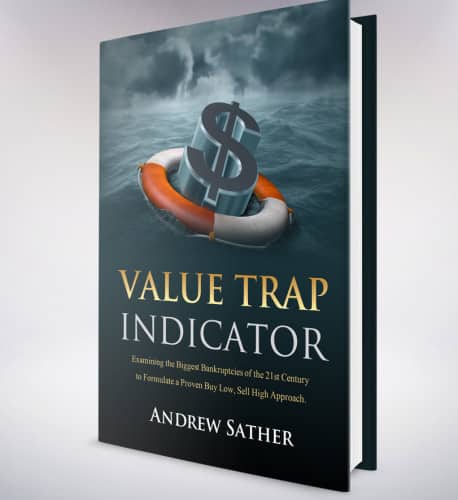The Value Trap Indicator is a numbers-based approach to avoiding dangerous value stocks. This indicator was formulated based on extensive research on 30 major bankruptcies from the S&P 500.
Because the greatest weakness of a value investing strategy is the value trap, this indicator is an attempt at avoiding such risks. It should, then, greatly increase chances of higher returns. This emphasis on avoiding major losses is for a good reason.
In fact, losing money while investing requires higher gains just to break even. As losses mount, the required gain to offset a loss becomes higher than the loss itself.
For example, a -10% loss requires an 11% gain to break even. While that’s not that serious, consider the gain needed on a bigger loss. A -50% loss requires a full 100% gain, double the percentage move, to offset. A loss of -75% needs a full 300% gain, or a 4x bagger, just to recover back to the initial amount.
It doesn’t take much experience in the markets to understand how much harder it is to find a 300% gainer than it is to lose -75%.
BEHIND THE NUMBERS: Value Trap Indicator
The Value Trap Indicator draws from seven different categories using common stock market metrics. The key is that it draws from common numbers that every financial company is required to submit to the SEC.
As such, companies regulated by the SEC will all have a Value Trap Indicator value. This protects the investor from most possible frauds, as these numbers are audited by professional accounting firms.
This gives investors a consistent and unemotional analysis on any stock. A numbers-based approach like this one will not fall victim to investor biases, market sentiment, or public perception. The numbers don’t lie, and they help keep us rational in an irrational world. The indicator is also effective because it doesn’t discriminate based on industry.

It’s true that, in general, you want to compare financial ratios within industries. But the Value Trap Indicator bypasses this requirement by considering all aspects of the financial statements. Because of this, it’s only natural that some industries will be more heavily favored than others. This isn’t undesirable. On the contrary, a good investor will recognize that this is a huge benefit.
The truth of the matter is that some business models are just better than others. Some industries just have higher demand or better efficiency than others. This is just a fact of life.
You see, the Value Trap Indicator will punish an industry that is underperforming. The simple reason is the financial ratios for the stocks in that industry won’t look good versus the rest of the market. Over time, the general U.S. economy grows at a steady pace. Various industries over and underperform that growth during different decades.
By utilizing a fair and equal measure for every company regardless of industry, the Value Trap Indicator increases its chances of investing in the booming industries and avoiding the failing ones.
In real times of economic turmoil, it’s not just one or two companies that are going bankrupt in a struggling industry. A decaying industry will see mass numbers of bankruptcies within itself during the toughest times. Other stronger industries will be perfectly fine and intact. Like with the financial banks in 2008 and the internet stocks in 2000, an industry comparison of financial ratios would’ve registered serious losses for your portfolio. You probably would’ve held some of the biggest losers.
Don’t let the industries drive your investing decisions. Hold all industries to a strict standard of profitability, and your portfolio will be rewarded.
Example: BORDERS BANKRUPTCY
Ironically enough, as I wrote this, there sat five packages from Amazon next to me. Amazon might’ve killed many bookstores, but Borders didn’t do much to help themselves. In the end, the Borders bankruptcy shows what happens when a company is slow to change.
I mention slow to change because Borders epitomized this characteristic. To say that they were slow to adapt to the internet would be an understatement. When internet sales first started to get off the ground, Borders shot themselves in the foot by outsourcing all of their internet purchases to Amazon. This was a grave mistake that eventually crippled their bottom line, seen especially evident in 2006 and later.
The final chapter of Borders’ book came on February 16, 2011, when they filed for Chapter 11 bankruptcy. The Ch. 11 was eventually converted to a Chapter 7, which just shows how miserable things really were. When it’s better to liquidate than re-organize, the business is failing catastrophically.
I’m guessing that the cold hard facts of this case will reveal that the average investor could have easily avoided being sucked into the bankruptcy. Forget the internet and retail talk, and let’s dive in. Here’s the last annual report filed before the Borders bankruptcy, on April 1, 2010.
BORDERS FINANCIALS
Like I mentioned before, the company was not profitable after 2006. Although it may have been able to prolong its survival, the bankruptcy filing was inevitable, baring a radical change or recovery. Neither of those things happened, and the company paid the price.
A very interesting takeaway from these financials involves the Value Trap Indicator numbers below (see book). Keep in mind that a Strong Sell (> 800; v5.5) was marked in all 4 years prior to bankruptcy.
VALUE TRAP INDICATOR
First and foremost, the debt to equity in 2010 is ridiculously high for a retailer. It’s too much debt for any company, let alone one that is fully dependent on the economic spending cycles of the consumer. The debt to equity ratio was also increasing every year. This is the only way that the company was able to stay afloat, and obviously, that’s not sustainable.
When you see debt levels growing at that fast of a pace, it should be triggering alarm bells all around.
Conclusion
Testing the indicator further reveals that investors would’ve been able to avoid 29 of 30 stock market bankruptcies since 2000, for an over 96% success rate. Turns out that bankruptcies aren’t as surprising as it may seem.
Complete access to the Value Trap Indicator can only be found here:
The Value Trap Indicator Book

